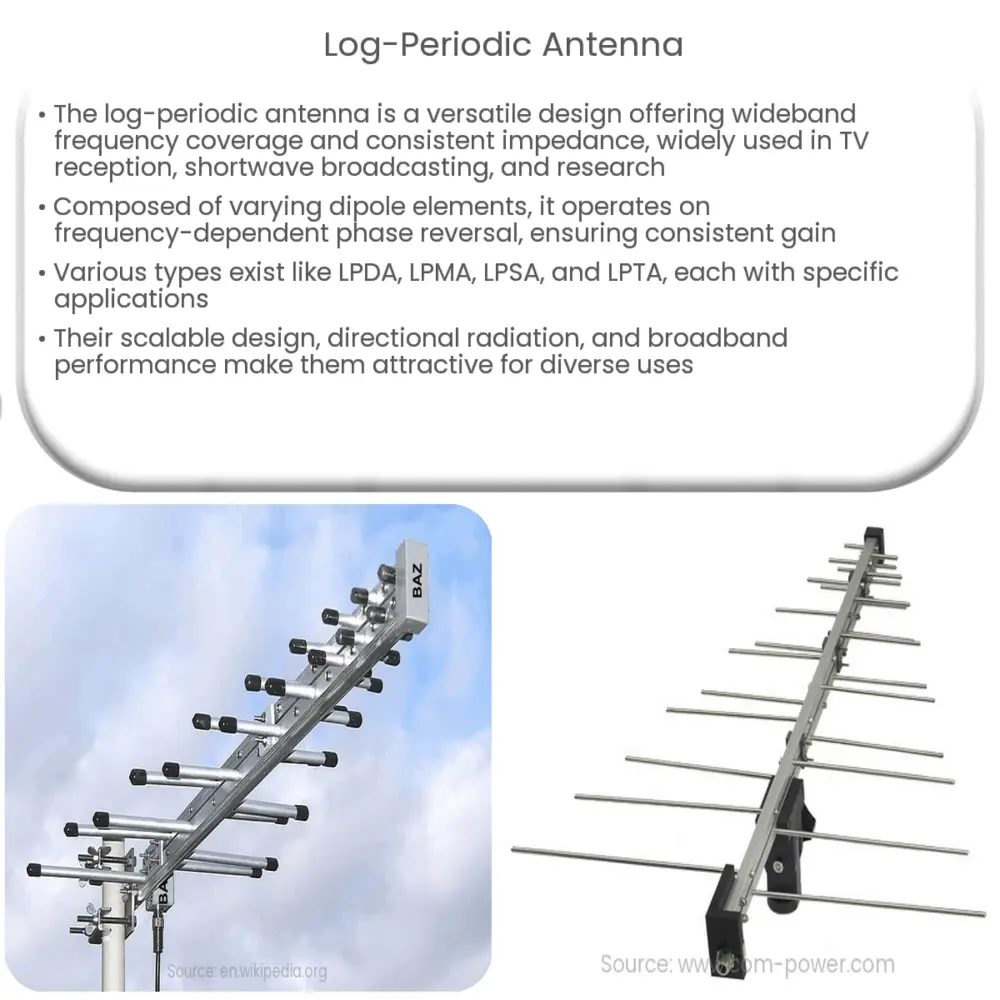Log-periodic antennas offer wideband frequency coverage, consistent impedance, directional radiation patterns, and adaptability for diverse applications.

Log-Periodic Antenna: An Overview
Introduction
The log-periodic antenna is a unique and versatile antenna design that has found widespread use in various applications, including television reception, shortwave broadcasting, and even scientific research. Invented by Raymond H. DuHamel and Dwight E. Isbell in 1957, this antenna offers a range of desirable characteristics, such as wideband frequency coverage, consistent impedance, and manageable directivity. This article aims to provide an introduction to the design and operation of log-periodic antennas and explore their key features and common applications.
Design and Operation
A log-periodic antenna consists of multiple dipole elements of varying lengths and spacings, arranged in a linear or planar configuration. These elements are typically made from conductive materials, such as aluminum or copper, and mounted on a non-conductive support structure. The crucial aspect of the log-periodic design is that the lengths and spacings of the elements follow a logarithmic progression, which gives the antenna its characteristic broadband performance.
The log-periodic antenna operates on the principle of frequency-dependent phase reversal, where each dipole element resonates at different frequencies. As the frequency increases, the resonant element shifts progressively towards the smaller elements. This creates a traveling wave that moves along the antenna structure, effectively providing a wideband frequency response with consistent gain and impedance characteristics.
Types of Log-Periodic Antennas
There are several types of log-periodic antennas, which can be broadly categorized based on their geometry:
- Log-Periodic Dipole Array (LPDA): This is the most common type of log-periodic antenna, characterized by a linear arrangement of half-wavelength dipole elements. The LPDA is commonly used for television reception and amateur radio applications.
- Log-Periodic Monopole Array (LPMA): Similar to the LPDA, the LPMA uses monopole elements instead of dipoles. This design offers improved performance in specific applications, such as ground-based communications systems.
- Log-Periodic Slot Array (LPSA): The LPSA features a series of slot elements cut into a metallic surface, resulting in a planar antenna structure. This design is often employed in radar and microwave applications.
- Log-Periodic Toothed Array (LPTA): This variation of the log-periodic design features tooth-shaped elements, which can provide better performance in certain frequency ranges.
Advantages of Log-Periodic Antennas
Log-periodic antennas offer several advantages that make them an attractive choice for various applications:
- Wideband Frequency Coverage: Due to their logarithmic progression of element lengths and spacings, log-periodic antennas can operate effectively over a wide range of frequencies. This makes them ideal for applications that require broadband performance, such as TV reception and shortwave broadcasting.
- Consistent Impedance and Gain: Log-periodic antennas maintain consistent impedance and gain across their operating frequency range, allowing for more predictable performance and simplified matching to transmitter or receiver circuitry.
- Directional Radiation Pattern: Log-periodic antennas exhibit a directional radiation pattern, enabling them to focus their energy in a specific direction, which can improve signal strength and reduce interference from unwanted sources.
- Scalability: The performance of a log-periodic antenna can be easily tailored to specific requirements by adjusting the number, lengths, and spacings of the elements, making it a highly adaptable design.
Applications of Log-Periodic Antennas
Thanks to their versatile characteristics, log-periodic antennas are used in a wide variety of applications:
- Television Reception: Log-periodic dipole arrays are commonly used as TV antennas due to their broadband performance, which allows them to receive multiple channels simultaneously.
- Shortwave Broadcasting: The wide frequency range and directional radiation pattern of log-periodic antennas make them well-suited for shortwave broadcasting, enabling reliable communication over large distances.
- Amateur Radio: Radio amateurs often employ log-periodic antennas for their ability to operate efficiently across multiple frequency bands, allowing for greater flexibility in communication modes and band choices.
- Radar and Microwave Applications: Log-periodic slot arrays are frequently used in radar and microwave applications due to their planar structure, which enables easy integration with associated electronic components.
- Scientific Research: Researchers in fields such as radio astronomy, ionospheric studies, and electromagnetic compatibility testing use log-periodic antennas to capture and analyze wideband signals across a broad range of frequencies.
Conclusion
The log-periodic antenna is a versatile and efficient design that offers a range of attractive features, such as wideband frequency coverage, consistent impedance, and directional radiation patterns. Its adaptable nature has led to its widespread use in various applications, from television reception and shortwave broadcasting to scientific research and amateur radio. As technology continues to advance, the log-periodic antenna will likely remain a popular choice for addressing the ever-growing demand for reliable and efficient wideband communication solutions.

